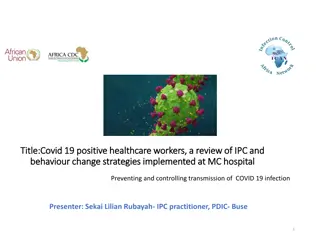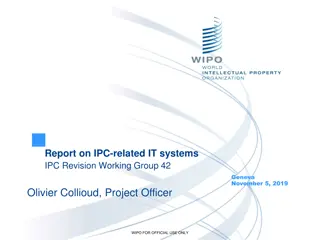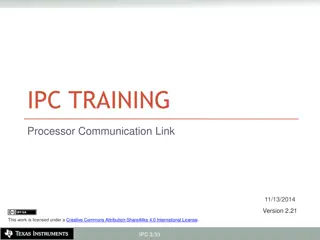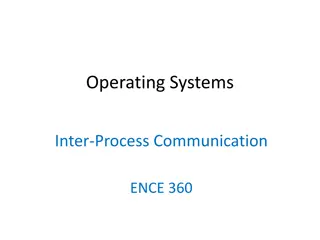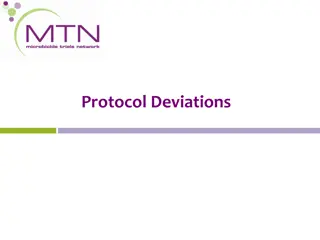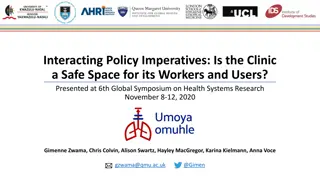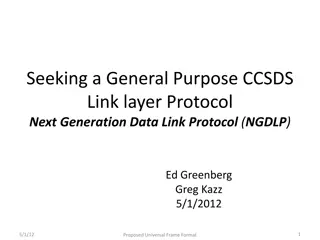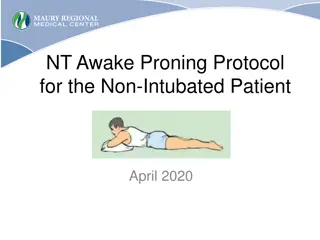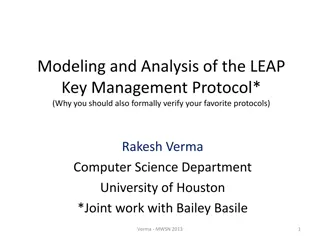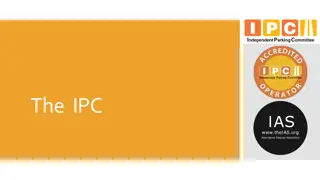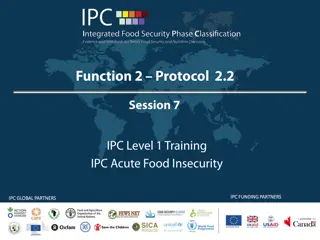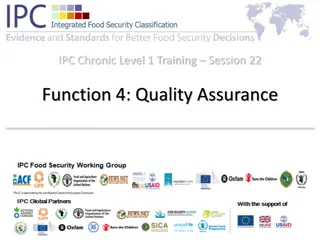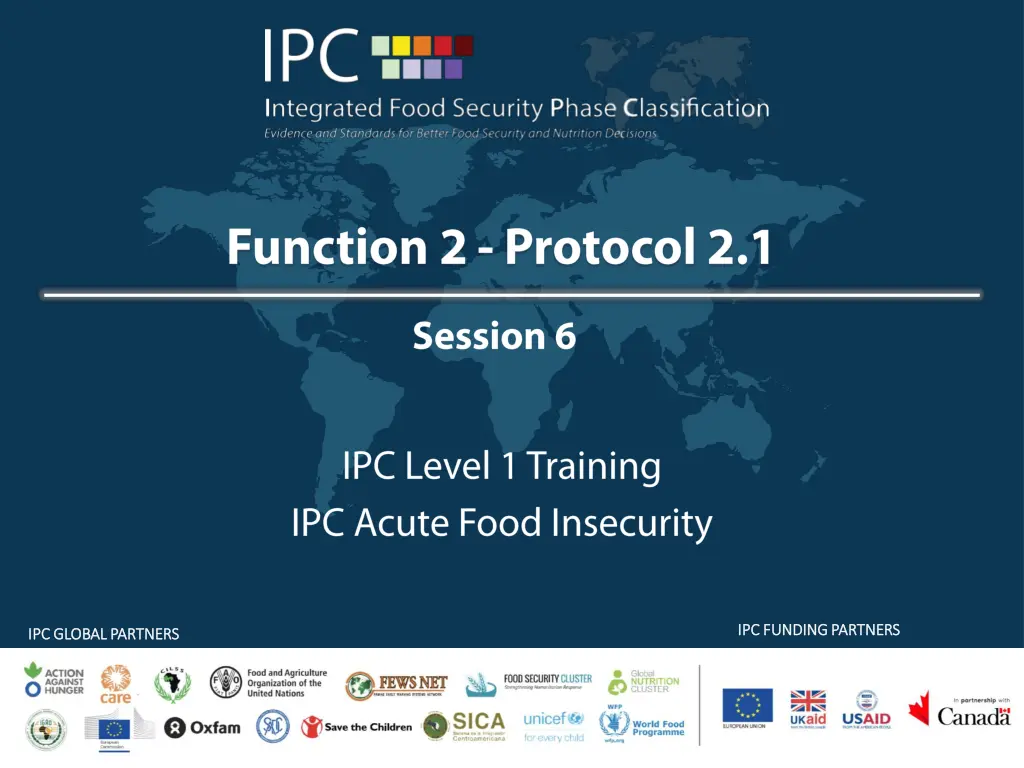
Analyzing Food Insecurity with IPC Analytical Framework
Explore how the IPC Analytical Framework guides the convergence of evidence to classify severity and identify key drivers in food insecurity situations. Learn about contributing factors, outcomes, and the overall process of contextualizing and validating outcomes using the framework.
Download Presentation

Please find below an Image/Link to download the presentation.
The content on the website is provided AS IS for your information and personal use only. It may not be sold, licensed, or shared on other websites without obtaining consent from the author. If you encounter any issues during the download, it is possible that the publisher has removed the file from their server.
You are allowed to download the files provided on this website for personal or commercial use, subject to the condition that they are used lawfully. All files are the property of their respective owners.
The content on the website is provided AS IS for your information and personal use only. It may not be sold, licensed, or shared on other websites without obtaining consent from the author.
E N D
Presentation Transcript
IPC FUNDING PARTNERS IPC FUNDING PARTNERS IPC GLOBAL PARTNERS IPC GLOBAL PARTNERS
Protocol 2.1: Use Analytical Framework to guide convergence of evidence What is the objective of Protocol 2.1? To guide converge of evidence for overall classification of severity and identification of key drivers How does Protocol 2.1 work? The Framework walks the analysts through a chain of events that drive food insecurity. IPC Classification is based on the COMPLETE SET of supporting (and contradictory) evidence, contextualized and critically reviewed following the IPC Analytical Framework.
How does the IPC Analytical Framework work? The Analytical Framework is primarily divided into Contributing Factors and Outcomes Outcomes manifested at household and area level Contributing Factors Feedback A.k.a. Drivers E.g. E.g. Drought Lack of resilience High prices Lack of income opportunities Food consumption Livelihood change Malnutrition Useful for: Useful for: - - - - Understanding what is driving the situation Having an idea of the expected severity Allowing inference of outcomes Contextualizing, triangulating and validating outcomes - Confirming and quantifying the severity and magnitude of food insecurity Global comparability -
The Contributing Factors Causal Factors: Uses the Risk, Hazard and Vulnerability & Sustainable Livelihoods Frameworks, including: Vulnerability Hazards Food Security Dimensions: Are directly impacted by the interaction of vulnerabilities & hazards and include: Availability Access Utilization Stability
The Outcomes Primary & Secondary Outcomes: 1 Outcomes: Any food insecurity must be expressed as food consumption and/or livelihood change 2 Outcomes: Nutrition and/or mortality are only expressed following 1o outcomes Exclusive and Non-Exclusive Outcomes: Exclusive to Food Security: Food consumption (represented by white box) Non Exclusive to Food Security: Livelihood change, nutrition and mortality (represented by partially shaded box)
Place Evidence in the Appropriate Place in the Framework Task: With a partner Exercise 6.1 1. You will be given 5 minutes to discuss the pieces of evidence provided to you and then to determine where the piece of evidence best fits on the IPC Analytical Framework. 2. When you have consensus, put each piece of evidence in the right place on the IPC Analytical Framework.
Supporting Slides on further explanation of each Element that Facilitator can add in between slides or at the end
Food Security Contributing Factors Risk, hazard and vulnerability
Food Security Contributing Factors Food security dimensions Dimensions interact in sequential and systematic manner: Food Availability: Actual or potential existence of food in the area Determined by production, trade, food stocks, wild foods and other aspects that affect physical presence of food Food Access: Actual or potential ability of households to acquire food Determined by factors such as own production, households stocks, aid, gifts, exchange, gathering and purchases. Food [Physical] Utilization: Ability of households to physically consume the food they were able to access. Determined by factors such as food storage facilities, food preparation, feeding practices, and access to sufficient quantity of potable water. Does not include [biological] food utilization as these are also driven by non-food issues, such as diseases. Stability: How steady the whole system is as households conditions are driven by past and future likely trends. Determined by factors such as duration of current crisis, past recurrence of crisis, future trends for projected period. 11
Food Security Outcomes First level outcomes Direct expression of lack of food security more useful to identify acute food insecurity Food consumption: If availability, access and utilisation are inadequate, also food consumption is likely to be inadequate. The severity of food consumption gaps depends on how inadequate one or more dimensions are, and whether households are resorting to livelihood coping in order to protect food consumption. If households are mitigating food gaps through negative livelihood coping the households are still considered to be food insecure as per the IPC Livelihood change: If households are experiencing difficulties in accessing food, they may engage in negative and unsustainable livelihood coping strategies, for example sale of assets or reducing expenditures in essential non-food items Livelihood changes such as migration may also take place for non food security specific factors. In this case these provide no evidence on livelihood change as a food security outcome, but their potential impact on food security dimensions and thereby on outcomes should be assessed If households are experiencing food gaps but not resorting to livelihood change, households are still considered to be food insecure as per IPC 12
Food Security Outcomes Second level outcomes Evidence on nutrition and mortality can not drive FS classifications, but can support or question the findings. Expressed following first level outcomes useful to confirm or reject assessment of acute food insecurity Nutrition: Inadequate food intake and disease, driven by food and non- food security specific factors are expected to increase acute malnutrition rates The links between food gaps and high malnutrition are expected to be more pronounced in higher Phases of Acute Food insecurity. Analysts are expected to assess if malnutrition rates are mainly due to food security or non-food security related factors. Mortality: Inadequate food consumption, negative livelihood change and elevated malnutrition rates may eventually be reflected in above usual mortality rates with a time lag. For IPC purposes trauma-related deaths should be discounted from CDR and U5DR. 13

